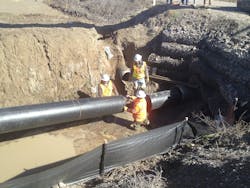Slip line saves sinking road in Oregon, prevents more damage
Drainage systems are critical components of any type of construction, and flooding is always a risk to consider when completing public works projects. Maintenance and rehabilitation to storm water systems must be performed quickly and efficiently to prevent any significant damage from forming or incurring higher costs to municipalities.
In April 2016, a two-lane highway in Ontario, Ore., experienced a serious situation when a corrugated metal pipe (CMP) failed, creating a void underneath the roadway. Corrosion and a partial collapse 20 feet inside the 30-in. diameter CMP brought forth significant leaks, which softened the surrounding soil. As a result, the topsoil and asphalt gave way, collapsing the road in the compromised area. This resulted in a large sinkhole opening up on the side of the road, presenting the need for an immediate fix.
Assistant District Manager Jeff Berry from the Oregon Department of Transportation (ODOT) was charged with assessing the problem. The ODOT’s objective was to quickly and successfully stabilize the roadway in order to prevent a larger sinkhole from forming. Because the culvert was located under a crucial road, the main challenge was finding a way to replace or rehabilitate the pipe without further disrupting the traffic pattern on the road above. A significant obstacle was the culvert’s placement. With 10 feet of fill between the CMP and the road, ODOT determined a rehab project would take four days to dig and replace the pipe.
NW Relining LLC, an Olympia, Wash.-based company, is a distributor for Snap-Tite products. Sales reps Grey Langemo and Bob Boyes teamed up with Berry to find a solution that would save time and money.
They decided to use 115 ft of 24-in., high-density polyethylene (HDPE) pipe to slip line and rehabilitate the existing CMP. The annular space was filled with grout to hold the liner in place. Though the diameter of the pipe decreased, the hydraulic flow capacity improved.
The Snap-Tite system will never rust or corrode. It is durable and long-lasting. The primary alternative to slip lining—digging up and replacing the pipe—would require the city to close the road, disrupt the flow of traffic, and cost the city large amounts of money and time. The new Snap-Tite liner will not leak and will last for decades to come, far outlasting the pipe it rehabilitates.
“Snap-Tite was able to provide us with a quick and efficient solution for rehabilitating the defective CMP culvert,” commented Berry.
A unique feature of Snap-Tite is that it does not require fusion to join the HDPE pipe together, making installation comparatively easy and inexpensive. The patented male/female machining at each end of the HDPE allows the pipe ends to be ‘snapped’ together, piece-by-piece, and pushed into the full length of the existing pipe. NW Relining LLC was able to provide training and support on the proper methods of slip lining HDPE. With this knowledge, the crew was able to quickly and independently rehabilitate the damaged CMP and begin work on repairing the sinkhole.
